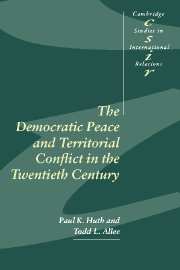Book contents
- Frontmatter
- Contents
- List of figures
- List of tables
- Acknowledgments
- 1 Another study of democracy and international conflict?
- 2 Pathways to conflict escalation and resolution in international disputes
- 3 The international strategic context
- 4 Domestic institutions and the Political Accountability Model
- 5 Domestic institutions and the Political Norms Model
- 6 Domestic institutions and the Political Affinity Model
- 7 Empirical results for decisions to challenge the status quo
- 8 Empirical results for decisions to offer concessions in negotiations
- 9 Empirical results for decisions to escalate with military force
- 10 What have we learned about the democratic peace?
- Appendices A–F
- Bibliography
- Index
- CAMBRIDGE STUDIES IN INTERNATIONAL RELATIONS
- References
Appendices A–F
Published online by Cambridge University Press: 22 September 2009
- Frontmatter
- Contents
- List of figures
- List of tables
- Acknowledgments
- 1 Another study of democracy and international conflict?
- 2 Pathways to conflict escalation and resolution in international disputes
- 3 The international strategic context
- 4 Domestic institutions and the Political Accountability Model
- 5 Domestic institutions and the Political Norms Model
- 6 Domestic institutions and the Political Affinity Model
- 7 Empirical results for decisions to challenge the status quo
- 8 Empirical results for decisions to offer concessions in negotiations
- 9 Empirical results for decisions to escalate with military force
- 10 What have we learned about the democratic peace?
- Appendices A–F
- Bibliography
- Index
- CAMBRIDGE STUDIES IN INTERNATIONAL RELATIONS
- References
Summary
This appendix is divided into two sections. In the first section we discuss the concept of a territorial dispute in international politics. The second section concerns coding issues that we addressed in our efforts to create a data set of territorial disputes.
Territorial conflict in the international system
In the twentieth century territorial conflict has centered upon six types of disputes:
Disputes between two states over competing claims to their homeland territory. These are typically disputes between neighboring states who disagree over the location of land or river borders, the sovereignty of offshore islands, or whether the very sovereignty and independence of neighbors should be recognized.
Disputes between two states with competing claims to the homeland territory of one state and the overseas territory of the other state. These disputes often have involved major powers establishing spheres of influence and colonial empires abroad, in which territorial conflict with local states emerged over the location of borders, the sovereignty of islands, and rights to military bases. For example, in the first half of the twentieth century, China raised the issue of leased territories with Britain and France and disputed its border with the British Empire in India. Other examples include Thailand's border with French Indochina, Ethiopia's borders with Italian and British colonies, and Liberia's borders with French colonies.
Disputes between two states whose competing claims involve the overseas territory of both states. These disputes arise when two colonial empires come into direct territorial contact with each other and the borders and rights to offshore islands need to be established. Good examples include border disputes among the European colonial empires in Africa and in the Middle East from the turn of the century to the end of World War II.
[…]
- Type
- Chapter
- Information
- Publisher: Cambridge University PressPrint publication year: 2003

